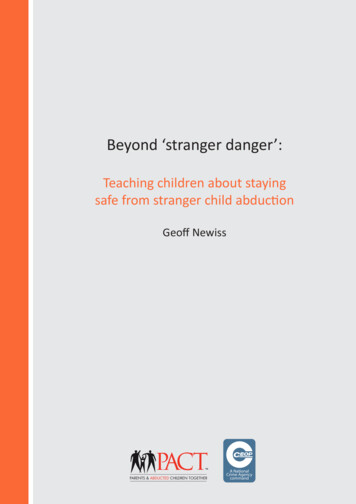
Transcription
Beyond ‘stranger danger’:Teaching children about stayingsafe from stranger child abductionGeoff NewissPARENTS & ABDUCTED CHILDREN TOGETHERA NationalCrime Agencycommand
Beyond ‘stranger danger’:Teaching children about stayingsafe from stranger child abductionGeoff Newiss
Parents and Abducted Children Together (PACT).No part of this book may be reproduced, stored in a retrieval system, or transmitted in anyform or by any means, electronic, electrostatic, magnetic tape, mechanical, photocopying,recording or otherwise, without permission of the publishers (PACT).Parents and Abducted Children Together, PO Box 31389, London, SW11 4WY, UKwww.pact-online.orgRegistered with the Charity Commission of England and Wales. Registration No. 1081904PACT is a certified non-profit 501(c)3 organisation. EIN 04-3631031National Crime Agencywww.nationalcrimeagency.gov.ukPrinted in England by Glazier Design, 112 Great Portland Street, London W1W 6PH
Beyond ‘Stranger Danger’AcknowledgementsThis study was supported by an Advisory Group of Jane Birkett (UK Missing Persons Bureau,National Crime Agency), Jon Brown (NSPCC), Dr Bernard Gallagher (University ofHuddersfield), Charlie Hedges (National Crime Agency CEOP Command), Brian Higgins(Missing People) and Louise Rutherford (Home Office).Additional advice was kindly provided by Jonathan Baggaley (National Crime Agency CEOPCommand), Chris Cloke (NSPCC), Claude Knights (Kidscape), PC Maria Nixon (HampshireConstabulary), Tink Palmer (Marie Collins Foundation), Karen Robinson (Missing People)and Kate Shillaker (Devon Child Assault Prevention Project).We are very grateful to all research participants for sharing their views and opinions.The research was made possible thanks to the excellent voluntary work of PACT’s Policyand Research Assistants Ava Carpenter and Hannah Walsh.
ContentsExecutive summary. 11.BACKGROUND . 42.SUBJECT OVERVIEW . 83.FINDINGS FROM THE RESEARCH. 144.DISCUSSION AND RECOMMENDATIONS . 255.References . 30Annex A . 32
Beyond ‘Stranger Danger’1Executive summaryEvery year about 50 children are abducted by a stranger. In some cases the child is sexuallyassaulted and, on rare occasions, murdered. Public attention will inevitably focus on thesetragic cases. But the police record over 200 attempted abductions by a stranger each year.Even unsuccessful abductions are deeply disturbing to communities, parents and childrenalike.This study, building on earlier work by PACT and CEOP, a National Crime Agency Command(NCA-CEOP), looks at the advice and information given to children on how to avoidabduction by a stranger. Thirty years ago simple ‘stranger-danger’ messages were commonplace, and even attracted government endorsement. Our research examines whether thisapproach remains relevant and effective.What is ‘stranger danger’?There is no definition of ‘stranger danger’. In effect, it is simply a slogan for child safetystrategies which focus on recognising, and taking action in response to, strangers. Whilstthe approaches, materials and methods may vary, the common themes are not to talk to,go with or take things from strangers.AimsThe study focused on three main aims:1. To establish whether parents, teachers, police and other agencies are providinginformation and advice to children on stranger child abduction;2. To explore what information and advice, if any, is provided to children;3. To identify themes or issues in the content or delivery of information and advice.MethodThe research involved data collection with parents, teachers, police, police communitysupport officers and representatives of the voluntary sector. In addition, previous researchon child abduction safety programmes was reviewed.The research is deliberately qualitative in style, with a focus on exploring and identifyingissues ‘from the ground up’. As a result, there is a natural limitation on how applicable thefindings are to a wider public.
2FindingsThe study finds that: Children increasingly struggle to distinguish between a stranger and a non-stranger,especially in an age of social media. Children who have had no abduction safety training will readily go with strangers whenpresented with a lure. Lack of resources and a heavy concentration on online safety mean many children donot receive anti-abduction training. Parents, teachers, the police and others expressed concern that anti-abduction advicefor children should not be needlessly frightening. The crucial distinction is not between strangers and non-strangers, but between wellmeaning adults and those with criminally abusive intent, whether strangers or not.Evidence and further researchAn important finding from this study is that relatively little scientific research has beenconducted into effective abduction prevention strategies in recent years. Importantknowledge gaps exist, for example on children’s changing perceptions of a stranger (in lightof their greater exposure to social media); whether abduction avoidance behaviours shouldbe taught on their own or as part of a broader programme on abuse; which factors (e.g.frequency of education classes, self-esteem) ensure that children maintain abductionavoidance behaviours; and the role parents should play in keeping their children safe.Education and broader prevention strategiesWhilst there is sufficient evidence to be sure that education plays an important part inpromoting children’s safety, it is not necessarily the only effective abduction preventionstrategy. A broader abduction prevention framework might also include, for example,strategies to tackle offender behaviour, the role of police and criminal justice agencies,community involvement, and environmental measures such as street lighting andsurveillance of public places. Consideration of these factors has been outside the scope ofthis study and should form the basis of any further work to develop comprehensiveabduction prevention strategies.
Beyond ‘Stranger Danger’3RecommendationsThis study offers five recommendations:1. Clear information on the scale and nature of child abduction should be accessiblenationally (this requirement will be progressively met by the setting up of the onlineChild Abduction Hub this year).2. New safety materials to help teachers and parents talk to children about stranger childabduction should be developed, tested and made widely available.3. These materials should consider carefully the degree to which advice to children shouldtake account of the different types of abduction to which they may be vulnerable, e.g.stranger, non-stranger and parental.4. Schools, police, local authorities and other agencies should review the strategiesemployed locally to keep children safe from stranger child abduction, in light of thefindings of this study.5. Further research as described above should be set in train without delay.
41. BACKGROUNDIn 2013, Parents and Abducted Children Together (PACT) with the Child Exploitation andOnline Protection Centre (now the National Crime Agency CEOP Command) publishedTaken: a study of child abduction in the UK (Newiss and Traynor, 2013).One of the main themes of Taken was the relatively high number of abductions perpetratedby strangers. Including attempted abductions, over 40 per cent of police cases involved astranger. Approximately 50 children were actually abducted by a stranger (during the oneyear period), and more than 200 attempts were made to abduct a child. Findings from twoseparate surveys of children suggest that incidents in which a stranger tries to take a child(and less commonly succeeds in doing so) occur on a daily basis in the UK, though many gounreported to the police (see chapter 2).‘Stranger danger’ initiatives came to prominence in the UK with the release of a series ofPublic Information Films during the 1970s and 1980s (available on the PACT website). Thesefilms were often used as a teaching aid in schools, sometimes delivered by a police officer.However, during the 1990s and 2000s questions were raised about whether ‘strangerdanger’ was effective in keeping children safe, and whether it detracted from thecomparatively greater risk posed by people known and related to children (again, seechapter 2 for further information).There is anecdotal evidence that some children are still told about ‘stranger danger’ byparents and/or teachers. Following attempted abductions or suspicious incidents, policeforces continue to issue ‘stranger danger’ alerts in the press, and schools often arrangesessions for children to be told about staying safe.However, there is no clear picture of exactly what children are told, by whom, and in whatcontext. It is not known how varied or uniform current safety advice is, whether it can beimproved, whether it is effective, and how many children it is reaching. Whereas numerousinitiatives have been launched in recent years to help parents and children navigate safeinternet use, there appear to have been few such developments to ensure children’s safetywhen outside. This report documents findings from new research and seeks to shed light onsome of these issues.What do we mean by ‘stranger danger’?There is no definition of ‘stranger danger’. In effect, it is simply a slogan for child safetystrategies which focus on recognising, and taking action in response to, strangers. Whilstthe approaches, materials and methods may vary, the common themes are not to talk to,go with or take things (etc.) from strangers.
Beyond ‘Stranger Danger’5AimsThe study focused on three main aims:1. To establish whether parents, teachers, police and other agencies are providinginformation and advice to children on stranger child abduction;2. To explore what information and advice, if any, is provided to children;3. To identify themes or issues in the content or delivery of information and advice.OutcomesThe study was conducted in the expectation that the findings would inform thedevelopment of new teaching resources (for parents and teachers) on stranger childabduction. In particular, new resources may benefit parents and teachers in communitiesdirectly affected by a stranger abduction or attempted stranger abduction.ScopeAbductions by a stranger are characterised by a child being lured, coerced or forced to gowith a perpetrator, at the risk of suffering immediate abuse 1. However, separating strangerabduction from other forms of abduction is not quite so ‘black and white’: Some abductions are precipitated by grooming, both online or face-to-face. Adultperceptions of someone being a ‘stranger’ may not be shared by children who havebuilt up some degree of familiarity with a person online or when out of the home. This study has not sought to examine the provision and content of online child safetymaterials. However, there is potential overlap in the purpose of online child safetymaterials and the more traditional ‘stranger danger’ approaches. Some views on thisare explored in the report. Some perpetrators who are known to their victims use a similar modus operandi as astranger abductor, luring a child to go with them in order to abuse them. Safety adviceneeds, ideally, to accommodate a broad range of abduction scenarios. Child abuse prevention strategies often teach children to recognise unsafe oruncomfortable situations, to understand when touching or cuddling is wrong, to knowthat some secrets should not be kept, and to tell a parent of other trusted adult ifsomeone has made them feel unsafe 2. Whilst these strategies are generally targeted atpreventing abuse from perpetrators known to the victim, they are also valuable forpreventing stranger child abduction.These issues are raised again in chapter 4.1Newiss and Traynor (2013) reveal that often a precise motive is difficult to determine forattempted stranger child abductions. However, sexual abuse is often considered the most likelyexplanation.2 See, for example, the NSPCC’s Underwear Rule: www.nspcc.org.uk/underwear.
6Stranger child abduction: case studiesA 12 year-old girl was walking back from the shops when a car pulled alongside her and theman inside asked her if she wanted a lift. She refused his persistent requests and keptwalking. The man stopped the car and quickly left the vehicle, causing the girl to run insidea nearby office block to seek help.A group of five 11 and 12 year-olds were playing in a park with their parents some 200metres away. A man had approached the group several times asking for their names butthen left them alone. When one of the group, an 11 year-old girl, wandered over to sometrees the man appeared and grabbed her arm, attempting to drag her behind the trees andbushes. The girl screamed and kicked, causing the offender to let go, and she fled back tothe group and her parents.Source: unpublished case studies taken from the Newiss and Traynor (2013) datasetMethodThe research involved a series of interviews with:ParentsParents with school-aged children were recruited in one area. Interviews were held at theparticipants’ home address. The participants were advised about the subject matter beforebeginning, and were made aware they could stop the interview if they no longer wished toproceed. None did. Interviews followed a conversational style rather than a formalinterview; some probes were used to direct responses to cover the aims of the research.In addition, an online discussion was posted on a local ‘Mum’s network’ attracting a short,but informative, dialogue.SchoolsPrimary schools in two areas were emailed and/or called and invited to participate in theresearch. Whilst many chose not to, some sent written responses. Loosely structuredinterviews were conducted in four schools.Online media monitoring (of abductions and attempted abductions) revealed several casesin which schools (from outside the interview areas) had sent letters to parents following alocal incident. Copies of letters or other safety materials were collected where possible.Police and voluntary sectorContact was made with representatives from three police forces, including PoliceConstables and Police Community Support Officers with first-hand experience of deliveringsafety classes in schools. Interviews were loosely structured, and a written response wascollected from one force representative.
Beyond ‘Stranger Danger’7In addition, the lead researcher attended two parents’ workshops and a teachers’workshop hosted by a regional voluntary organisation (the Devon Child Assault PreventionProject) and interviewed the project manager. Finally, representation was taken from twonational charities working in the field of child/personal safety.The research is deliberately qualitative in style, focusing on identifying and exploring issues‘from the ground up’. This approach is ideal when research is concerned with conceptualdevelopment and meaning, rather than measuring.There is, however, a natural limitation on how applicable the findings are to a wider public.As a result, the findings best show the variety and type of issues raised; they are not a goodmeasure of the prevalence of any particular concern or issue.Structure of the reportChapter 2 provides important context to the study, setting out key findings and conclusionsfrom the previous literature on child abduction and the development of child abductionsafety strategies. Chapter 3 presents the findings from this research with parents, teachers,police and other agencies. Chapter 4 offers a discussion and recommendations.
82. SUBJECT OVERVIEWUnderstanding the circumstances of child abduction – who commits it, why and how – isvital to the development of effective prevention strategies and materials (Boudreaux et al.,2000). This section provides a short review of what is known about stranger child abductionin the UK, followed by a summary of previous research on child safety strategies targeted atstranger abduction. Together these give important context to the new research findingspresented in chapter 3.Stranger child abductionHow many stranger child abductions occur?Each year in the UK police forces record more than 500 offences of child abduction 3. Inaddition, more than 1,000 offences of kidnapping are recorded by police, though it’s notpossible to tell how many involve children rather than adults 4.The last comprehensive analysis of police child abduction data was undertaken by Newissand Traynor (2013), published by PACT and the Child Exploitation and Online ProtectionCentre (NCA-CEOP Command). This report collected data on a total of 592 cases (involving675 victims) of child abduction or kidnapping (of a child) recorded by 49 of the (then) 52 UKpolice forces in 2011/12.One of the main themes was the relatively high number of abductions perpetrated by nonfamily members. 247 cases (44 per cent 5) were committed by a stranger (defined assomeone who was not known to, or recognised by, the victim). In 47 of these cases, theperpetrator succeeded in taking a child. There were 186 attempted abductions; and in 14cases it was insufficiently clear (from the data made available) whether the abduction hadbeen completed or not (see Table 1).3In 2012/13, 514 offences of child abduction were recorded in England and Wales, and 43 inNorthern Ireland. Typically over 200 offences of ‘abduction’ are recorded in Scotland each year,though this total includes adults as well as children. For more information on the legal offencecategories, recent trends and statistical limitations see Newiss and Traynor (2013).4In 2012/13, 1,387 offences of kidnapping were recorded in England and Wales, and 56 in NorthernIreland. The offence of kidnapping does not exist in Scotland.5The percentage excludes cases where the relationship between the victim and offender was notknown (n 29), giving a revised total of 563 cases.
9Beyond ‘Stranger Danger’Table 1: Number of stranger abductions 2011/12 (police data)Relationshipbetween victimand ionsNot known ifattempted or notTotalcasesn (%)n (%)n (%)n (%)47 (19%)186 (75%)14 (6%)247 (100%)This table shows only the data for ‘stranger’ perpetrators. Figures on parental (n 98), otherfamily (n 12), ‘other known’ (n 206) and perpetrators where the relationship betweenvictim and offender was not known (n 29) are available in the full report (Newiss andTraynor, 2013). Percentages do not sum to 100 because of rounding. Figures are for thenumber of cases. Some cases involved more than one victim. In total 273 children werevictims of stranger abduction or attempted abduction in the 247 cases.Survey data has highlighted the gap between the number of offences of childabduction recorded by police in the UK, and the self-reported experiences of youngpeople themselves.Radford et al. (2011) asked a random probability sample of children and youngadults in 2009 if – at any time in their childhood – anyone had tried to kidnap them.Kidnapping was described to the participants as an incident when they were madeto go somewhere, for example in a car, by someone who they thought might hurtthem. 0.2 per cent of those under 11 years old, 1.9 per cent of 11 to 17 year-olds,and 2.1 per cent of 18 to 24 year-olds reported an attempted kidnap. Nearly half ofthe attempted kidnappings (in each age group) were perpetrated by a stranger.Gallagher et al. (2008) carried out a survey of 2,420 school children in the NorthWest of England in 1996/7. Forty-one children (1.7 per cent of the sample, or 1 in59 children) reported a stranger tried to get them to go with them when they didnot want to at some point in their childhood, and four children (0.2 per cent of thesample, or 1 in 605 children) reported a stranger succeeded in taking them away.Whilst findings from the surveys conducted by Gallagher et al. and Radford et al.are not directly comparable, they do suggest that young people’s experiences ofabduction and attempted abduction far exceed the number of incidents that cometo be recorded as crimes by the police. Many incidents are simply not reported tothe police (Gallagher et al. found that 60 per cent of victims of attempted abductiondid not report the incident to the police).
10Who is abducted?Victims of stranger abduction (in Newiss and Traynor’s sample) ranged in age from 0 to 18years old, with a mean age of 11 years. Nearly four-fifths were aged 9 or over at the time ofthe offence.Two-thirds of the children (in Newiss and Traynor’s study) were female. However, thesurvey conducted by Gallagher et al. (2008) found no significant difference between thenumber of boys and girls reporting abduction or attempted abduction by a stranger.Where ethnicity was recorded, 87 per cent of victims of stranger abduction (in Newiss andTraynor’s study) were white, 5 per cent black, 6 per cent Asian, and 2 per cent ‘other’.What are the typical circumstances of stranger child abduction?Gallagher et al. (2008) reported that nearly all victims of attempted or actual abductionwere approached by the offender when outdoors (for example on the street or in a park).Newiss and Traynor (2013) found that nearly two-thirds of attempted abductions by astranger reported to police involved a perpetrator in a vehicle. Whilst most childrensuffered no injury, nearly half the victims were grabbed, dragged or held by the offender(ibid.).Gallagher et al. (2008) found that nearly three quarters of victims were with other childrenor adults at the time of an abduction or attempted abduction. Newiss and Traynor (2013)highlighted 22 cases (in 2011/12) in which young children were with their parent or carerwhen an attempt was made to take them, mostly from public places such as a shoppingcentre, play area or the street.The motive for stranger-perpetrated offences, particularly attempted abductions, is oftendifficult to determine with certainty. However, a large proportion is believed to be sexuallymotivated (Newiss and Traynor, 2013; Finkelhor et al., 2002; Bourdreaux et al., 1999).Newiss and Traynor (2013) collected data on 15 children who were actually abducted by astranger in which the motive was clearly sexual. Five suffered a sexual assault or rape.Five victims first met the offender online, reflecting a growing concern about the use ofmobile and internet technology, including social networking sites, in grooming people forsexual exploitation (CEOP, 2013; Lilley and Ball, 2013; Jago et al., 2011; Paskell, 2013). A UKsurvey of 1,031 nine to 16 year-olds who use the internet as part of the EU Kids Onlineprogramme, found that 4 per cent had met in person with an individual they firstencountered online (Livingstone et al., 2010).Some children are abducted by strangers in more unusual circumstances. Newiss andTraynor (2013) found eight cases in which a child was abducted for revenge or because of adispute. These were typically older children, all were male, who were more likely to beinjured as a result of the incident. Five children were abducted by a stranger for financialgain, either in a kidnap and ransom scenario or as a result of being robbed. Four youngchildren were victims of an attempt to take them from a school or hospital by a perpetratorposing as a family member or representative of social services.
Beyond ‘Stranger Danger’11Stranger child abduction safety adviceResearch in both the UK and the United States (US) has examined a range of child safetytraining programmes focused on abduction by a stranger.Resisting luresMany programmes concentrate on training children to resist strangers’ lures. Researchconsistently shows that children will readily go with strangers when presented with a lure(Holcombe et al., 1995; Poche et al., 19981; Moran et al., 1997).Poche et al. (1981) distinguished between simple lures (‘would you like to go for a walk?’),authority lures (‘your mother told me to come pick you up’) and incentive lures (‘I havesome toys in my car ’) (cited in Miltenberger and Olsen, 1996). Holcombe et al. (1995)added two other lure types: assistance lures (‘can you help me carry these things to mycar?’) and conversation lures (‘what is your name, how old are you?.’).Miltenberger and Olsen (1996) identify three critical behaviours a child should performwhen confronted with an abduction lure: verbal, motor and reporting behaviour. Thesehave been characterised widely as ‘yell, run and tell’ (see, for example, Kidscape Protectchildren from paedophiles, undated).Acquisition of abduction avoidance behavioursMiltenberger and Olsen’s (1996) review of numerous studies found that behavioural skillstraining ‘involving some combination of instructions, modelling, rehearsal, praise andcorrective feedback’ is generally effective in helping children to acquire abductionavoidance behaviour.The critical point here is that simply giving a child the conceptual knowledge about personalsafety (telling them the rules) is a poor method for ensuring they adopt the right behaviourwhen the situation requires (see also Moran et al., 1997). Kraizer et al. (1988) stress thatknowing the right answers in a pencil-and-paper personal safety test is not a good predictorof children’s ability to perform abduction avoidance behaviours in a simulated abductionscenario. Learning through action is required. Kraizer et al. (1988) explain:Children learn through a combination of discussion, role-play, application of skills tovaried situations, and successive building and refinement of the child’s ability to actuallyuse the techniques being taught Children need an opportunity to clear out their ownmisconceptions, to receive new information and then to practice new skills so they makethem their own – so they become part of the child’s repertoire in everyday life.Miltenberger and Olsen’s (1996) review suggests that whilst both individual and grouptraining is effective, the former appears more so. Studies of classroom-based group trainingindicate that some children appear not to learn the desired behaviours, though teachersare more effective when equipped with a protocol for conducting behavioural skillstraining. Evidence suggests that safety videos should be used in addition, rather thaninstead of, the full array of behavioural skills training.The same review also concluded that people trained to deliver behavioural skills trainingwere more effective in instilling abduction avoidance behaviours in children than parents.
12However, the authors clarify that the findings suggest better teaching materials need to bemade available to parents; it is not that parents are incapable of teaching their children(ibid.)Finally, research has highlighted the important role that self-esteem seems to play inchildren’s ability to acquire abduction avoidance skills. Kraizer et al., 1988 summarise:Children who had high self-esteem going into the [personal safety training] programwere more successful Self-esteem appears to be a desirable precondition to theintervention, enabling assimilation of the information presented This is significantbecause many practitioners have intuitively felt that self-esteem plays an important rolein personal safety education.Maintenance of abduction avoidance behavioursVarious studies have examined children’s maintenance of abduction avoidance behavioursusing ‘in situ probes’ (Miltenberge and Olsen, 1996) in which a mock-abductor unknown tochildren who have received abduction training presents them with a lure in a real setting.Holcombe et al. (1995) found maintenance strategies (using verbal rehearsal, modelling,feedback and role play) to be generally effective though long-term maintenance requiresrepeated intervention.Importantly, Holcombe et al. (1995) also found that children both acquire and maintain themotor avoidance behaviour ('run’) better than they do the verbal behaviour (‘yell’).Children’s understanding of, and response to, strangersOther research has highlighted the difficulties of a ‘stranger’ based approach to keepingchildren safe from abuse and abduction. Mayes et al. (1990) found that (particularly young)children demonstrate only a tenuous grasp of the concept of a stranger and non-stranger,and differentiate poorly between them.Moran et al. (1997) studied the verbal responses of 168 children (aged 6, 8 and 10 yearsold) to video sequences of child interactions with strangers as well as familiar and semifamiliar adults. They found that more than half of 6 and 8 year-olds signalled they would becompliant to a stranger making a request, offer or demand. Ten year-olds were less likely tocomply with an offer from a stranger (with just over 20 per cent complying) thoughcompliance increased when the stranger made a request (40 per cent were compliant) or ademand (just over half were compliant).The study by Moran et al. (1997) also demonstrates the tendency of children to complywith adults making a request or demand because of the socialization process whichencourages children to be helpful, respectful and obedient to adults. Self-interest (standingto gain something or enjoy something) is also a powerful factor in children’s willingness toaccept an offer from a stranger (ibid.).A child’s propensity to be obedient can also be used to control them once they are underthe control of an abductor. Elliot (2000) cites the example of a three year-old girl ab
stranger, non-stranger and parental. 4. Schools, police, local authorities and other agencies should the strategies review employed locally to keep children safe from stranger child abduction, in light of the findings of this study. 5. Further research










